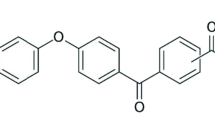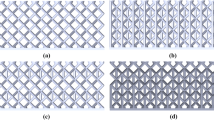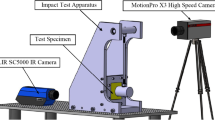Abstract
In this work, using a commercially available polyjet printer (Stratasys J850 Prime 3D printer), digital materials with varying concentrations of viscoelastic Agilus30 and Vero plastic materials are created and studied under static and dynamic loading. Digital and hybrid materials with varied Shore A hardness values of 30, 60, and 95 are produced by mixing Agilus30 Black with VeroMagentaV. Then their mechanical damage behavior was studied. For static tensile tests, dog-bone specimens are used at different strain rates. Rectangular samples are used when an elliptical-shaped defect is introduced in the center. To capture the energy absorption characteristics of the printed samples, dynamic impact experiments are conducted using a drop mass impact machine. It is observed that the hybrid material SH95 mostly deforms more rigidly, while the hybrid material SH30 and SH60 exhibit more elongation and flexibility. In other words, we observe that increasing SH level stiffens the hybrid materials. The total impulse or momentum change of the impact event is a clear indicator of the performance of a dynamically loaded material. In terms of energy absorption, the longer time a load can be dissipated over indicates a “more protective” material. We observed that the time in which the compression phase of the impact event happened over got larger with the increasing concentration of Agilus30. As such, the drop impact experiment reveals a nonlinear link between material composition and acceleration reduction. Overall, we observe that the static and dynamic mechanical properties of the hybrid materials can be tuned by varying the processing conditions and compositions.













Similar content being viewed by others
Data availability
The data that support the findings of this study can be made available on request from the corresponding author (Ashfaq Adnan, aadnan@uta.edu).
References
T, Wohlers, T. Gornet, History of additive manufacturing 2014. Wohlers Report 2014 - 3D Printing and Additive Manufacturing State of the Industry, 1–34 (2014).
S. Wickramasinghe, T. Do, P. Tran, FDM-Based 3D printing of polymer and associated composite: a review on mechanical properties, defects and treatments. Polymers (2020). https://doi.org/10.3390/polym12071529
S.H. Ahn, M. Montero, D. Odell, S. Roundy, P.K. Wright, Anisotropic material properties of fused deposition modeling ABS. Rapid Prototyp. J. 8(4), 248–257 (2002). https://doi.org/10.1108/13552540210441166
J.W. Stansbury, M.J. Idacavage, 3D printing with polymers: challenges among expanding options and opportunities, in Dental materials, vol. 32, (Elsevier Inc., 2016), pp.54–64
L. Zorzetto, L. Andena, F. Briatico-Vangosa, L. De Noni, J. Thomassin, C. Jérôme, Q. Grossman, A. Mertens, R. Weinkamer, M. Rink, D. Ruffoni, Properties and role of interfaces in multimaterial 3D printed composites. Sci. Rep. (2020). https://doi.org/10.1038/s41598-020-79230-010
J. Smith, P, Petrovic, M. Rose, C, De Souz, L, Muller, B, Nowak, J. Martinez, Placeholder text: a study. J. Citat. Styles 3 (2021)
M. Martorelli, A. Gloria, C. Bignardi, M. Calì, S. Maietta, Design of additively manufactured lattice structures for biomedical applications. J. Eng. (2020). https://doi.org/10.1155/2020/2707560
A, Jackson, L.M. Ahmad, A. Adnan, On the Static and Dynamic Energy Absorption of Additively Manufactured Lattice Structures. (2023).
S.D. Nath, S. Nilufar, An overview of additive manufacturing of polymers and associated composites. Polymers 12(11), 2719 (2020). https://doi.org/10.3390/polym121127196587/abe353
W. Gao, Y. Zhang, D. Ramanujan, K. Ramani, Y. Chen, C.B. Williams, P.D. Zavattieri, The status, challenges, and future of additive manufacturing in engineering. CAD Comput. Aided Des. 69, 65–89 (2015). https://doi.org/10.1016/j.cad.2015.04.001
I. Gibson, D. Rosen, B. Stucker, Additive manufacturing technologies: 3D printing and direct digital manufacturing. Johnson Matthey Technol. Rev. 59(3), 498 (2015)
R. Sheng, 3D Printing: a revolutionary process for industry applications. 3D printing: a revolutionary process for industry applications (Elsevier, 2022), pp.1–192
J. Nomani, D. Wilson, M. Paulino, M. Mohammed, Effect of layer thickness and cross-section geometry on the tensile and compression properties of 3D printed ABS. Mater. Today Commun. 22, 100626 (2020)
M. Algarni, S. Ghazali, Comparative study of the sensitivity of PLA, ABS, PEEK, and PETG’s mechanical properties to FDM printing process parameters. Crystals 11, 995 (2021)
Y.L. Tee, P. Tran, M. Leary, P. Pille, M. Brandt, 3D printing of polymer composites with material jetting: mechanical and fractographic analysis. Addit. Manuf. 36, 101558 (2020)
O. Grimaldo Ruiz, M. Rodriguez Reinoso, E. Ingrassia, F. Vecchio, F. Maniero, V. Burgio, M. Civera, I. Bitan, G. Lacidogna, C. Surace, Design and mechanical characterization using digital image correlation of soft tissue-mimicking polymers. Polymers 14, 2639 (2022)
E.M. Agaliotis, B.D. Ake-Concha, A. May-Pat, J.P. Morales-Arias, C. Bernal, A. Valadez-González, P.J. Herrera-Franco, G. Proust, J.F. Koh-Dzul, J.G. Carrillo, E.A. Flores-Johnson, Tensile behavior of 3D printed polylactic acid (PLA) based composites reinforced with natural fiber. Polymers 14, 3976 (2022)
T.S. Lumpe, J. Mueller, K. Shea, Tensile properties of multi-material interfaces in 3D printed parts. Mater. Des. 162, 1 (2019)
V.D. Cojocaru, D. Frunzaverde, D. Nedelcu, C.O. Micloșină, G. Mărginean, Study regarding the influence of the printing orientation angle on the mechanical behavior of parts manufactured by material jetting. Mater. Plast. 58, 198 (2021)
ASTM International, Standard test method for rubber property—durometer hardness (ASTM D2240-15). West Conshohocken, PA: ASTM International. https://www.astm.org/Standards/D2240.htm (2021)
Vero material data sheet PDF | Stratasys - . (n.d.). Retrieved 2 Apr 2023, from https://www.stratasys.com/contentassets/ab69196d173842cca634d07febba0f10/mds_pj_vero_0221a-2.pdf?v=4a1902 (2023)
The Stratasys J850 Prime PolyJet 3D printer. (n.d.). Retrieved 2 Apr 2023, from https://stratasys-corporate-prod-slot.dxc.stratasys.com/contentassets/f5e7f8431584452abfd3f73ac2ab489d/br_pj_j8seriesbrochure_0522a.pdf?v=4aa449 (2023)
ASTM D638–14, Standard test method for tensile properties of plastics. ASTM International, West Conshohocken. http://www.astm.org. (2014)
Acknowledgements
This work has supported by the Department of Navy’s HBCU/MI Program (Award # ONR N00014-21-1-2750) through the Office of Naval Research: Mr. Anthony Smith, Program Director). This grant is associated with the Distinguished Fellow Program Award received by A.A. A.A. also acknowledges the financial support from Office of Naval Research (ONR)’s Force Health Protection (FHP) program (through the Award # ONR: N00014-21-1-2051 and ONR: N00014-19-1-2383: Dr. Timothy Bentley, Program Manager).
Author information
Authors and Affiliations
Contributions
LA and AJ both contributed to the conceptualization, methodology, software, validation, building of experimental setup and data acquisition system, investigation, and writing—original draft. AA: initial conceptualization, methodology, validation, writing—review & editing, funding acquisition.
Corresponding author
Ethics declarations
Conflict of Interests
The authors have no competing interests or conflict of interests.
Additional information
Publisher's Note
Springer Nature remains neutral with regard to jurisdictional claims in published maps and institutional affiliations.
Rights and permissions
Springer Nature or its licensor (e.g. a society or other partner) holds exclusive rights to this article under a publishing agreement with the author(s) or other rightsholder(s); author self-archiving of the accepted manuscript version of this article is solely governed by the terms of such publishing agreement and applicable law.
About this article
Cite this article
Ahmad, L.M., Jackson, A. & Adnan, A. Static and Dynamic Mechanical Properties of 3D printed Digital Materials. Multiscale Sci. Eng. (2024). https://doi.org/10.1007/s42493-024-00107-9
Received:
Revised:
Accepted:
Published:
DOI: https://doi.org/10.1007/s42493-024-00107-9









